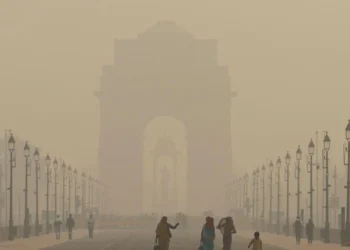As Myanmar enters its fifth year of military dictatorship, children bear the brunt of brutal crackdowns. Documented deaths, abuses, and psychological trauma paint a harrowing picture of innocent lives shattered amid escalating airstrikes and ethnic violence. This is the second part of our three-part series on this tragic issue.
BY Navin Upadhyay
May 17, 2025
In Myanmar, a nation fractured by the military junta’s brutal rule since its February 2021 coup, children are not just caught in the crossfire—they are deliberate targets of a campaign of terror. From villages razed by airstrikes to detention centers echoing with screams, the youngest victims of this conflict endure killings, torture, abductions, and a host of abuses that have shattered lives and futures. As the crisis enters its fifth year, the toll on Myanmar’s children paints a grim portrait of a generation scarred by violence, with the international community struggling to respond to a humanitarian catastrophe unfolding in plain sight.
A Relentless Death Toll: Children in the Line of Fire
Since the military seized power, children have borne a disproportionate share of the junta’s wrath, targeted in crackdowns on protesters, ethnic minorities, and resistance fighters. By June 2021, the Assistance Association for Political Prisoners (AAPP) documented at least 72 children under 18 killed by junta forces, a figure widely considered an undercount due to unreported deaths in remote ethnic regions like Karen, Kachin, and Shan States. By mid-2022, UN Special Rapporteur Thomas Andrews reported at least 382 children killed or maimed since the coup, with many falling victim to deliberate attacks—sniper fire in protests Ascot rifle fire in Mandalay, or indiscriminate airstrikes on villages. The National Unity Government (NUG), Myanmar’s exiled opposition, recorded 90 child deaths in 2021, a number that surged to 165 by the end of 2022—a 78% increase—driven by intensified artillery barrages and airstrikes targeting civilian areas.
I can’t stop thinking about his face.
The pain. The fear. The helplessness.
It’s not just war—it’s what the military junta has done to us.
A father clutching a wounded child, victims of a regime that bombs, tortures, and kills its own people.
This is Myanmar under the coup. pic.twitter.com/up1C0z3NeY— Aung Kyaw Hein (@phoepyar) May 15, 2025
The violence reached new heights in 2024, reflecting the junta’s escalating desperation as resistance groups gained ground. UNICEF reported at least 600 children killed or injured, with airstrikes and shelling claiming a significant share of lives. Amnesty International documented over 750 children killed or injured by year’s end, including a harrowing September airstrike on a displaced persons’ camp in Shan State that killed six children among eight civilians. The UN High Commissioner for Human Rights noted 88 children among 1,853 deaths in military custody, many following brutal torture. The AAPP’s comprehensive 2024 tally recorded 248 children among 1,824 civilian deaths, a sharp rise from 1,639 in 2023, signaling the junta’s increasingly retaliatory tactics.
These figures—UNICEF’s 600, Amnesty’s 750, and AAPP’s 248 confirmed deaths—reveal the challenges of documenting casualties in a country plagued by internet blackouts, military blockades, and restricted access for investigators. Conflict zones like Sagaing, Rakhine, and Kachin remain particularly opaque, with local reports suggesting the true toll is significantly higher. For instance, a May 2024 drone attack in Rakhine killed an estimated 200 Rohingya, including dozens of children, though exact numbers remain unverified due to access restrictions.
ALSO READ: Horror Myanmar Children Face (1): Bombed, Shot, Executed
Torture and Abuses: A Catalog of Atrocities
The junta’s cruelty extends far beyond killings, with children subjected to a horrifying array of torture and abuses. By mid-2022, the UN documented 142 children tortured in military custody, a number experts believe has grown substantially. Detained for suspected ties to resistance groups or as proxies for their parents, children endure beatings, cigarette burns, sexual assault, and mock executions. Human Rights Watch reported cases of children having fingernails or teeth ripped out, being forced to kneel on sharp objects, or being suspended without food or water for days. A 17-year-old boy, interviewed by investigators, recounted enduring cigarette burns and stress positions during interrogation at a military facility in Yangon, his screams ignored as interrogators demanded information he didn’t have.
Abductions are a pervasive tactic, with children seized as hostages to coerce parents into surrendering. In February 2023, junta troops detained 80 children under 12 at a monastery school in Sagaing, holding them for two days as leverage against resistance fighters. Some were as young as six, separated from their families and subjected to psychological torment. Forced recruitment is another scourge, with the military conscripting thousands of youths, including Rohingya children, into service. In 2024, the UN reported that children as young as 14 were coerced into carrying supplies or acting as human shields, often under threat of death.
Sexual violence is rampant, with documented cases of rape, forced nudity, and invasive searches in detention centers. A 15-year-old girl from Kayin State, whose identity is protected, told Amnesty International of being raped repeatedly by soldiers during a 2023 raid, her trauma compounded by the stigma she faced upon release. Children in conflict zones are also vulnerable to trafficking and child labor, driven by economic collapse and a humanitarian crisis that has displaced 3.5 million people, including over 1 million children. Malnutrition, lack of healthcare, and disrupted education are widespread, with over 13,000 schools closed, leaving 7.8 million children without formal schooling.
ALSO READ: Shirui Lily Festival: Naga, Kuki Chiefs Unite for Peace Amid KSO Leader’s Hate Speech
In Rakhine State, Rohingya children face a double threat, caught between the junta and the Arakan Army. They endure bombings, forced recruitment, and blocked humanitarian aid, with entire communities trapped in open-air prisons. A January 2024 airstrike in Sagaing killed nine children attending a church service, their bodies buried in makeshift graves as survivors fled. Such incidents are not isolated but part of a systematic campaign to instill fear and crush resistance.
Survivors’ Stories: Voices from the Chaos
The human cost is vividly captured in the stories of survivors. Thirteen-year-Old Aung, from Sagaing, lost his parents in a 2023 village raid and now lives in a displacement camp, scavenging for food. “I saw my father shot,” he told a local aid worker. “I dream of it every night.” In Kachin, 16-year-old Mai, abducted and forced to serve as a porter for junta troops, escaped after months of beatings but bears scars across her back. “They treated us like animals,” she said, her voice trembling. These stories, collected by groups like Save the Children and Fortify Rights, highlight the psychological toll—post-traumatic stress, anxiety, and depression—that plagues countless children.
A Humanitarian and Political Failure
The crisis is compounded by Myanmar’s humanitarian collapse. Over 18.6 million people, half the population, need aid, yet funding for UN appeals remains critically low—only 12% funded in 2024. Military blockades have choked off food, medicine, and shelter, with 700,000 people displaced in the past year alone. Children in displacement camps face starvation, with UNICEF reporting that 3.7 million children are malnourished. The closure of schools and health facilities has created a lost generation, with girls particularly vulnerable to early marriage and trafficking.
Politically, the junta’s impunity fuels the cycle of violence. Despite international condemnation, the military faces minimal consequences, with vetoes by China and Russia blocking UN Security Council action. ASEAN’s peace plan, launched in 2021, has been dismissed as ineffective, with the junta ignoring calls for dialogue. Resistance groups, including the NUG and ethnic armed organizations, have gained ground, but their advances have prompted fiercer junta reprisals, further endangering civilians.
The international community’s response has been criticized as inadequate. UN officials, including High Commissioner for Human Rights Volker Türk, have called for targeted sanctions, arms embargoes, and International Criminal Court referrals to hold junta leaders accountable. In 2024, the UN General Assembly adopted a resolution urging states to halt arms transfers to Myanmar, citing the junta’s “gross violations” against children. Rights groups like Amnesty and Human Rights Watch have urged governments to suspend economic ties with junta-linked businesses, which fund the military’s campaign.
Yet, enforcement remains weak. Countries like India, Thailand, and Singapore continue indirect trade with Myanmar, while China supplies weapons and infrastructure support. Advocacy groups have called for a global coalition to pressure the junta, similar to efforts against apartheid-era South Africa, but geopolitical rivalries and economic interests have stalled progress.













